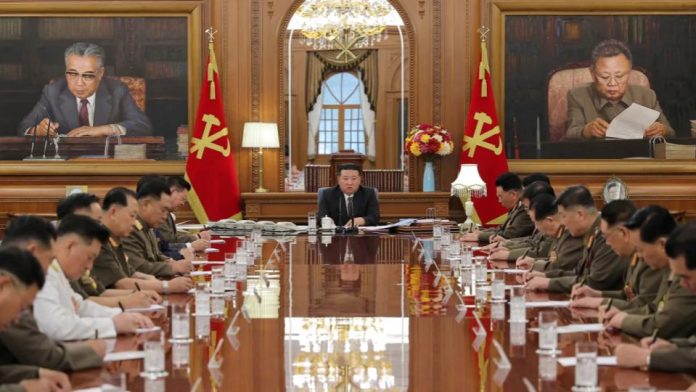In a recent development, North Korean leader Kim Jong Un has taken a significant step by dismissing his top general and initiating a reshuffle within the country’s military leadership. The move comes as Kim Jong Un instructs his armed forces to be ready for a potential conflict, according to reports from state media.
General Pak Su Il, who held the position of Chief of the General Staff, has been relieved of his duties. In his place, Vice Marshal Ri Yong Gil has been appointed to take on the crucial role, as stated by the Korean Central News Agency (KCNA), a state-run news outlet.
During a meeting of the Central Military Commission held on Wednesday, various changes were made to the leadership team, including the removal, transfer, and appointment of “leading commanding officers.” While specific details were not provided, this restructuring hints at significant shifts within North Korea’s military hierarchy.
This move follows a pattern of regular changes in North Korea’s military leadership. Some leaders resurface in different capacities after their removal, while others fade from public view entirely.
The new top general, Ri Yong Gil, has experienced a dynamic career trajectory. He ascended to his current position, the second-highest rank in the North Korean military hierarchy, as recently as December 31. This appointment reflects the complexity and fluctuations often seen in the country’s military leadership.
Analysts note that Ri Yong Gil has a longstanding history within North Korea’s military elite. He has weathered ups and downs throughout his career, including rumors of execution during a personnel reshuffle seven years ago.
The motive behind Kim Jong Un’s military reshuffle is open to interpretation. Cheong Seong-chang, a senior analyst at a private think tank near Seoul, suggests that the reasons might extend beyond punitive measures. Kim Jong Un’s history of promoting, demoting, and dismissing officials could reflect a method of holding them accountable rather than solely punishing them.
Leif-Eric Easley, a professor of international studies at Ewha Womans University in Seoul, speculates that Kim Jong Un’s motivations may include preventing the emergence of powerful figures below him. By frequently rotating leadership positions, Kim could be aiming to maintain his authority and avoid challenges to his rule.
The reshuffle announcement was tucked towards the end of the KCNA report, which primarily focused on the urgent need for military preparedness in light of the “grave political and military situation prevailing in the Korean Peninsula.”
While the report did not explicitly mention South Korea or the United States, it alluded to them indirectly, referring to “the chief culprits of deteriorated situation” on the peninsula. The meeting’s primary agenda was highlighted as “making full war preparations” in response to escalating tensions.
North Korea’s recent increase in military rhetoric, including threats to shoot down US reconnaissance planes and displays of advanced ballistic missile technology, has raised concerns internationally. The country’s saber-rattling includes testing a Hwasong-18 intercontinental ballistic missile with potential capability to strike the US mainland.
Against this backdrop of heightened tension, Kim Jong Un has directed war drills involving the deployment of North Korea’s latest weaponry. Meanwhile, South Korea has announced plans for a nationwide civil defense drill, aimed at preparing citizens for potential provocations from Pyongyang.

